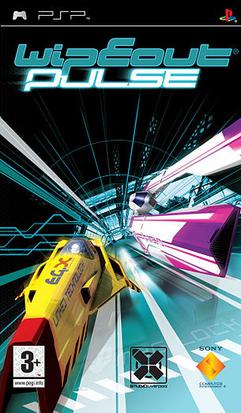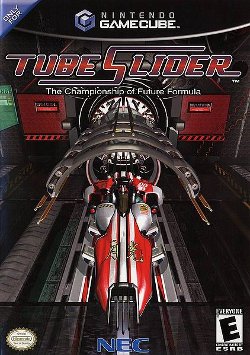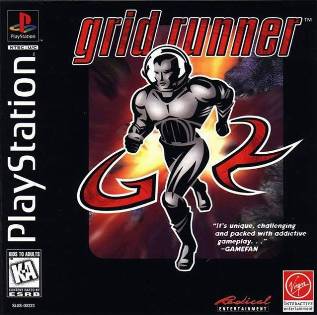Wipeout is a series of futuristic anti-gravity racing video games developed by Studio Liverpool.

Wipeout 2097 is a 1996 racing video game developed and published by Psygnosis for the PlayStation, the second installment of the Wipeout series following the original game released the previous year. It was ported the following year to Microsoft Windows and the Sega Saturn, and later also to Amiga and Macintosh.

Wipeout Fusion is a 2002 futuristic racing video game developed by Studio Liverpool and published by Sony Computer Entertainment for the PlayStation 2. The fifth instalment in the Wipeout series, following Wipeout 3 (1999), it was the first as well as the only original Wipeout title for PlayStation 2, with a port of Wipeout Pulse in 2009 being the only other Wipeout released on the platform. The game takes place in 2160 and revolves around players competing in the F9000 anti-gravity racing league. Wipeout Fusion received positive reviews upon release, with particular praise being directed at its techno soundtrack, but its graphics and track design received mixed responses from critics.

Wipeout Pure is a 2005 futuristic racing video game developed by Studio Liverpool and published by Sony Computer Entertainment for the PlayStation Portable. It was released as a launch title for the platform in North America and PAL territories, in March and September respectively. The sixth installment of the Wipeout series, following Wipeout Fusion (2002), the game takes place in the year 2197, exactly 100 years after the events of Wipeout 2097 (1996), and revolves around players competing in the FX300 anti-gravity racing league.

Crash Nitro Kart is a 2003 kart racing game for the PlayStation 2, Xbox, GameCube, and Game Boy Advance; versions for the N-Gage and mobile phones were released in 2004. It is the second racing game in the Crash Bandicoot series after Crash Team Racing and the first game in the series to feature full motion videos.

Need for Speed II is a 1997 racing video game released for PlayStation and Microsoft Windows. It is a part of the Need for Speed series and is the second installment, following The Need for Speed.

Beetle Adventure Racing! is a racing game released for the Nintendo 64 in 1999. It was developed by Paradigm Entertainment and EA Canada, and published by Electronic Arts. Each vehicle in the game is a Volkswagen New Beetle, which was released the previous year. The gameplay involves racing other players on unlocked tracks, finding and destroying crates, and collecting colored ladybugs while battling other players. The single-player championship offers three circuits and a secret bonus circuit with new vehicles and tracks available upon completion.

Blasteroids is the third official sequel to the 1979 multidirectional shooter video game, Asteroids. It was developed by Atari Games and released in arcades in 1987. Unlike the previous games, Blasteroids uses raster graphics instead of vector graphics, and has power-ups and a boss.

MegaRace is a racing video game developed by Cryo. It features pre-rendered 3-D graphics and over twenty minutes of full-motion video of fictional game show host Lance Boyle. It was released for DOS in 1993. It was then released for the Sega CD and the 3DO the following year. It spawned two sequels, MegaRace 2 and MegaRace 3.

Destruction Derby 2 is a 1996 vehicular combat racing video game developed by Reflections Interactive and published by Psygnosis for PlayStation and Microsoft Windows. The sequel to Destruction Derby (1995) and developed by the same team, players race with the goal of earning points by damaging opponent cars. Standard races and matches based in arenas with the goal of remaining the last player driving are also available.

Sonic Riders: Zero Gravity is a hoverboard racing video game developed by Sonic Team and published by Sega for the PlayStation 2 and Wii. It is the fifth pure racing game in the Sonic the Hedgehog series, and the second entry in the Sonic Riders trilogy, a spin-off of the main series.

Creature Shock is a 1994 sci-fi game released for MS-DOS and 3DO. It was developed by Argonaut Software and published by Virgin Interactive Entertainment. The game was later ported to the CD-i, Sega Saturn and PlayStation video game systems.

Wipeout Pulse is a 2007 futuristic racing video game developed by Studio Liverpool and published by Sony Computer Entertainment for the PlayStation Portable. It was released initially in PAL territories, followed by North America in February 2008, and later a PlayStation 2 port in Europe in June 2009. The game is the seventh installment of the Wipeout series and serves as a sequel to Wipeout Pure (2005). It takes place in 2207 and revolves around players competing in the FX400 anti-gravity racing league.

2Xtreme is a racing game released for the PlayStation in 1996 and a sequel to ESPN Extreme Games. Unlike the original, the game does not bear ESPN licensing. In it, the player races against others in various events around the world using Rollerblading, skateboarding, biking, and snowboarding. A sequel, 3Xtreme, was released in 1999.

Fragile Allegiance is an open-ended 4X real-time strategy (RTS) game from Gremlin Interactive, released in 1996 for MS-DOS and Windows 95. The game begins on May 25, 2496, as the player begins their employment with TetraCorp who have set up a new asteroid mining franchise operation in the Fragmented Sectors. There are six alien races competing with Tetracorp for these resources. Beginning with one building and one million credits, the player is tasked with building up a successful mining operation to sell as much ore as possible to the Federation. Diplomacy is crucial to the success or failure of this franchise operation as the players' colonies begin to encroach on one another.

Tube Slider is a 2003 racing video game developed by NDcube and published by NEC Interchannel for the GameCube. It was released only in North America; a Japanese release was planned but canceled for unknown reasons. The game takes place on Earth in the middle of the 21st century, where a new sport based around tube sliding was born out of people's desire for speed and competition, after hydrogen-based energy replaced fossil fuels in motorsports. The player can choose between one of eight futuristic formula vehicles, each one varying in terms of performance, and race against computer-controlled opponents across ten tracks divided into three sessions.

Off-World Interceptor is a 1994 third-person vehicular combat video game, developed and published by Crystal Dynamics and originally released on 3DO. An alternate version of the game was later released for the Sega Saturn and PlayStation consoles, named Off-World Interceptor Extreme. The two versions of the game have identical core gameplay elements, though the Extreme version is tweaked to feel more like the arcade mode in the original Off-World Interceptor.

Grid Runner is an action game developed by Radical Entertainment and published by Virgin Interactive Entertainment for the Sega Saturn, PlayStation, and Microsoft Windows in 1996. It is frequently described as a cross between tag and capture the flag, but the playing field is a maze-like grid which the players can manipulate to an extent. Players can either compete against each other in one-on-one matches or take on a series of AI opponents in the game's story mode. Grid Runner was first announced under the title "Eurit".

Star Raiders is a video game for the Xbox 360, PlayStation 3, and Microsoft Windows. Developed by Incinerator Studios, it was published in May 2011 by Atari Interactive. It is a re-imagining of 1980's Star Raiders which was the killer app for the Atari 8-bit computers. The remake is an action, first-person spaceship combat game in which the player travels through a starfield in pursuit of the enemy Zylons. It adds a new storyline, customizable ships, and multiplayer gameplay with several modes.

Hot Wheels Micro Racers is a racing video game developed by Unique Development Studios (UDS) and published by Mattel Interactive for Microsoft Windows. The game is based on the Hot Wheels toyline, and was unveiled at the American International Toy Fair in February 2000, as a competitor to Micro Machines. Hot Wheels Micro Racers was released on April 28, 2000, and came packaged with a free Hot Wheels car and poster.

















